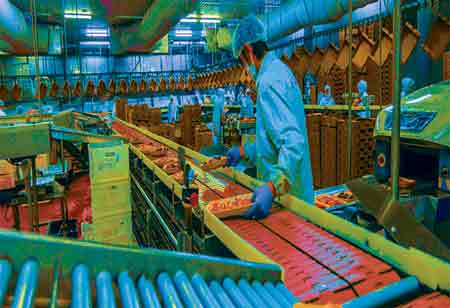THANK YOU FOR SUBSCRIBING
Be first to read the latest tech news, Industry Leader's Insights, and CIO interviews of medium and large enterprises exclusively from Food and Beverage Tech Review
Advantages of Robotics in Food Production
There has been a worldwide increase in food needs.

By
Food and Beverages Tech Review | Monday, January 02, 2023
Stay ahead of the industry with exclusive feature stories on the top companies, expert insights and the latest news delivered straight to your inbox. Subscribe today.
The global demand for food has increased. Automating various processes, including preparing, cooking, packing, sorting, and pasteurization, has also been a priority for food processors.
FREMONT, CA: There has been a worldwide increase in food needs. Food processors have also sought to automate various procedures, such as prepping, cooking, packing, sorting, and pasteurization. Food can be dispensed, sliced, packaged, and cased by machines before being placed in containers and sealed. The expansion of robotics in food processing has had varied effects on the sector, as described below.
Automation enhances food safety: Diverse nations worldwide are implementing efforts to improve food safety and security. Due to improper handling, a substantial amount of food becomes contaminated during manufacture. Companies are searching for ways to enhance the issue by reducing the amount of times workers come into contact with food throughout the production process.
Preparation, slicing, and packaging are all handled by automated machinery in the food processing industry, and they ensure that workers do not transmit diseases to food during production. In addition, it is easier to clean the equipment, which significantly reduces bacterial contamination of food.
Automation allows for greater production volumes in less time: The ability to quickly create large quantities of food is a key competitive advantage since it enables the firm to satisfy demand successfully and reduce the cost of manufacturing each unit.
Robots can work at predetermined speeds for extended periods with consistent consistency and perform things more swiftly and efficiently than human hands. Using robotics's efficiency in food production, commercial food processors can simultaneously release many items on the market.
Automation ensures the same level of work quality: Robots do not get tired and can perform the same task repeatedly without compromising quality. Consistently producing the same quality in commercial food processing is essential for brand perception and customer retention. Humans cannot achieve the appropriate level of uniformity when using hand tools to do operations such as measuring, chopping, and packaging.
Diverse processes are streamlined by automation, reducing errors: Automation reduces food processing procedures to only the most important steps. Using a food processor eliminates the need for someone to go through the chopped food, for instance. You are convinced that the sizes of the parts are accurate. Streamlining production allows a corporation to process food more quickly and at a lower cost.
In addition, using robotics in food production reduces the likelihood of process-related errors. Human errors include incorrect ingredient measurements, lost products, and weight estimates. Errors that occur less frequently minimize food waste while maintaining product quality.
Automation reduces labor costs: By automating various repetitive tasks in the manufacturing sector, firms can reduce labor costs. Any business that wishes to create massive quantities of food products may require a large workforce, resulting in a hefty labor expenditure. Other costs are associated with training and managing a workforce of this size. Automation conducts these jobs using a single or a small number of machines, whose costs are offset by the labor savings they produce.
Equipment Reduces Downtime
Human mistakes and staffing concerns may slow the production process, resulting in delays and bottlenecks. Errors are less likely to occur in a process when it is automated.
Many devices can also accommodate greater capacity, particularly during the food harvesting season, lowering the likelihood of bottlenecks. Lastly, unless undergoing cleaning or maintenance, machines can operate continuously, ensuring the production schedule is met.
I agree We use cookies on this website to enhance your user experience. By clicking any link on this page you are giving your consent for us to set cookies. More info


However, if you would like to share the information in this article, you may use the link below:
https://www.fbtechrevieweurope.com/news/advantages-of-robotics-in-food-production-nwid-1488.html





